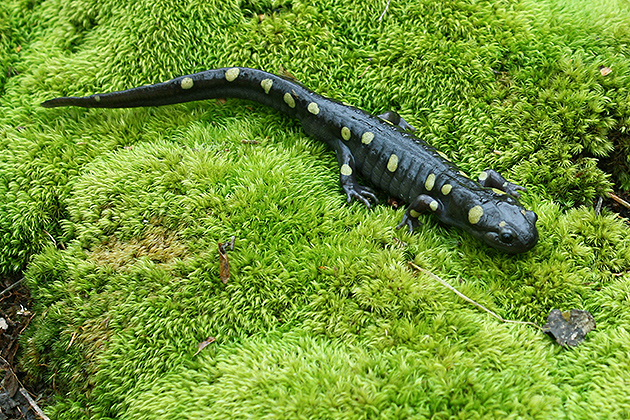
In an article published May 29 in the Proceedings of the Royal Society, B UConn biologist Mark Urban reports results of a study that may fundamentally alter how scientists view the importance of evolution in ecological research.
Urban, an assistant professor of ecology & evolutionary biology in the College of Liberal Arts and Sciences, studies ecological and evolutionary mechanisms that shape natural communities across multiple geographic locations. In this study, ‘Evolution mediates the effects of apex predation on aquatic food webs,’ he demonstrates that the evolutionary divergence of populations is just as important as the biodiversity patterns in nature that are based on ecological features, such as the presence of a top predator.
The subjects of this research are the marbled salamander (Ambystoma opacum), which is considered an apex (or top) predator, the spotted salamander (Ambystoma maculatum), and their shared zooplankton prey. The former salamander species breeds in the autumn and its larvae grow under the ice of ephemeral ponds during winter. As a result, marbled salamander larvae eat zooplankton all winter and grow large enough to eat the spotted salamander larvae that hatch in these same ponds in the late spring.


However, Urban has discovered that spotted salamanders sharing space with marbled salamanders have evolved so that they are born with voracious appetites, causing them to forage intensely. This increased foraging makes sense, given that these salamanders live in ponds that have been largely depleted of zooplankton prey due to the presence of marbled salamanders. The smaller salamanders need to eat enough so that they grow quickly and reach a size at which marbled salamanders cannot easily capture them.
“The evidence suggests that repeated evolution of high foraging rate in multiple spotted salamander populations constitutes an adaptive response to local selection from marbled salamander predation,” says Urban.
Since both species of salamander eat zooplankton, a natural assumption might be that in a competition for food both salamanders would eat the same zooplankton species. But Urban found that the two species of salamander actually prefer to dine on different species.
“As it turns out,” he says, “spotted salamander populations from marbled salamander ponds increase zooplankton diversity by feeding on the most common taxa – or groups – of organisms. This facilitates an even distribution of food among community members, and serves to reduce the apex predator’s top-down ecological effect on the composition of zooplankton in the ephemeral ponds.”
Urban further explains that the local adaptation of spotted salamander larvae influences the effects of the larvae of the marbled salamander on the abundance, diversity, and composition of temporary pond communities. These locally adapted spotted salamanders exacerbate the top predator’s effects on biomass and density of zooplankton, but buffer its effects on the diversity and composition of the zooplankton.
“To understand how marbled salamanders structure communities, we must understand both its direct ecological effects as a predator and its indirect effects via the natural selection it imposes on the spotted salamander.
“Just knowing that the presence of an apex predator will not necessarily reliably represent the true strength of top-down effects because adaptive evolution may disguise strong ecological effects is a breakthrough,” Urban says, “and it means that a broad range of ecological predictions are likely to be unreliable if we ignore how evolution affects community dynamics.”
Urban refers to this as ‘the invisible finger of evolution’ which, he says, may either tip the scales toward ecological influences (as with biomass density of zooplankton) or against ecological influences (as with zooplankton diversity).
He says knowing that the effect of an apex predator may be so strong that it causes compensatory evolutionary responses in other species shows that ecology and evolution are inexorably intertwined.
Alan Tessier, program director of the National Science Foundation Division of Environmental Biology which funded the research, says that by looking closely at the separate and interactive contribution of genetic and environmental factors shaping pond food webs, “We have a growing understanding of the genetic variation within species, and the eco-evolutionary processes that explain patterns of biodiversity.”


